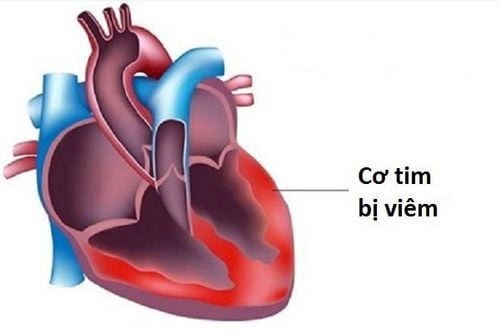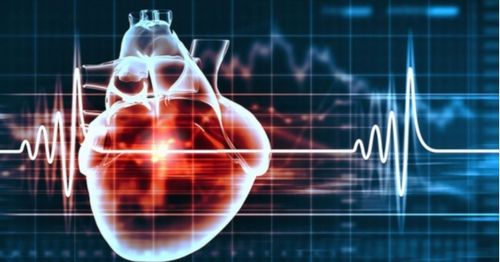This is an automatically translated article.
The article is professionally consulted by Master, Doctor Hoang Thi Hoa - Cardiologist - Department of Medical Examination and Internal Medicine - Vinmec Ha Long International General Hospital.The mortality rate is very high if acute myocarditis occurs but is not detected and treated in time. Myocarditis is very common in young people; it should be noted that cases of chest pain and dyspnea co-occur in the setting of an acute viral infection.
1. What is myocarditis?
Myocarditis is a term that refers to acute or persistent inflammation of the myocardium that becomes chronic, with or without valvular or pericardial involvement. The process of myocardial damage due to inflammation affects the function of pumping blood to the body, affecting the electrical activity of the heart muscle, leading to arrhythmias. Manifestations of myocarditis vary from mild to severe depending on the clinical patient. In severe cases, complications of heart failure can occur, with or without the formation of blood clots that cause stroke or myocardial infarction.
Myocarditis is a disease with a long history, with cases first described around 1600 AD. The number of people dying from myocarditis is increasing year by year, about 300000 people in 2015. The disease can appear at any age but is most common in young people in the age group of 20 to 40 years.
2. Causes of myocarditis
Causes of myocarditis are quite diverse and abundant, including viruses, bacteria, fungi, radiation and chemicals, drugs. Some cases of myocarditis appear postpartum or in heavy drinkers without clear evidence of the aforementioned pathogens. According to many statistics, viruses are the most common group of pathogens, accounting for more than 50% of cases. The viruses that cause myocarditis commonly seen in clinical practice are Coxsackie virus A4, A16, belonging to the Enterovirus group. The virus can be isolated from nasal secretions, pharyngeal secretions, myocardial tissue, or from the feces of patients in the acute phase of the disease. The severity of myocarditis as well as the clinical course is very variable, depending on the causative agent. Diphtheria virus myocarditis occurs in children often with severe cases, with a mortality rate higher than 80%.

Có nhiều nguyên nhân khác nhau gây viêm cơ tim
3. The danger of myocarditis
Diagnosis of myocarditis at an early stage is challenging because at this time the symptoms of the disease are often vague, even the patient does not have any abnormal clinical manifestations. Patients with mild disease often have only transient left chest pain, shortness of breath when doing heavy work or moving a lot, concomitant with symptoms of an acute viral infection such as high fever, severe headache, and fatigue. whole body,... These symptoms are often explained by fatigue due to overwork or common cold, so patients are subjective and easy to miss.
When entering the late stage, patients with myocarditis have to face more severe symptoms such as prolonged chest pain, arrhythmia such as tachycardia, shortness of breath appearing even at rest, edema of the lower extremities, .. Depending on the causative agent of myocarditis, the patient may also have other symptoms of myocarditis suggesting the cause, such as skin rash, nerve and joint symptoms, and burning pain. pharyngitis,... Patients with myocarditis often die at this stage due to complications of the disease, including:
Arrhythmia: Myocarditis affects the electrical activity of the heart causing irregular heartbeat, frequent tachycardia. Stroke or myocardial infarction: Ineffective ejection of blood in patients with myocarditis, causing blood to pool and increasing the likelihood of clots forming. When these clots travel throughout the body and block a blood vessel in the brain or coronary artery, it causes a stroke or a heart attack, respectively. Acute heart failure: If not treated promptly, damage to the heart muscle occurs causing heart failure. Damage to cardiac muscle tissue can be long-lasting and irreversible.
Myocarditis is diagnosed usually based on a combination of clinical and laboratory findings. The commonly used means are echocardiography, electrocardiogram, quantification of antibodies against viruses or bacteria suspected of causing disease, biopsies of cardiac tissue, etc. It is important to increase the possibility of early recognition of inflammatory diseases. Myocarditis is to always consider myocarditis when suspected, and seek to rule out other similar presenting cardiovascular diseases.
Patients, especially young people, need to go to medical facilities as soon as they have unusual symptoms. The condition of having symptoms of chest pain, shortness of breath while having symptoms of a cold is a suggestion that should not be ignored. When the disease progresses to a late stage with severe symptoms, the patient needs to be taken to the emergency room or resuscitated with aggressive treatments.
4. Measures to treat myocarditis
The treatment of myocarditis is often not easy because the patient is often diagnosed late when the disease has entered the late stage with many serious complications. The choice of treatment depends on the causative agent of myocarditis. The principles of treatment need to ensure the correction of arrhythmias and the prevention and resolution of heart failure complications that can increase the survival rate in patients with myocarditis.
Treatment of myocarditis is currently mainly supportive treatment and symptom resolution for patients. If you are lucky enough to know that the cause is an infection or a fungus, specific antibiotics or antifungals can be used. Critical cases must be hospitalized for more aggressive treatment.

Khám và tầm soát tim mạch định kỳ giúp nhận diện các yếu tố nguy cơ tim mạch
5. Prevention of myocarditis
Myocarditis is a disease mainly caused by viruses, currently there is no specific method of prevention. However, in order to minimize the possibility of disease, a number of measures to help protect health and potentially prevent myocarditis have been introduced such as:
Ensure hygiene, regularly wash hands with sanitizer solution. Wash hands or with soap, especially after using the toilet and before eating to prevent the disease from spreading widely. Do not use stimulants Limit the possibility of HIV transmission Protect the body from insect bites, wear long clothes, or use drugs, chemicals to repel insects. Limit close contact, talk or be near patients who are infected with viruses or flu, especially with immunocompromised subjects, the elderly and children. However, if you must be close to the sick person, you should use a mask to prevent the spread of the disease. Myocarditis is really a dangerous disease because the mortality rate of the disease is still very high, if the subjects are children, the mortality rate can be up to 75%. Adults with myocarditis also do not have much better results, only a small number of cases can resolve on their own. Patients with viral myocarditis can lead to many serious complications such as enlargement of the heart chambers, fibrosis, heart failure and reduced blood ejection function to the body. Without a heart transplant, the mortality rate in the first 2 years is 50%, increasing to about 80% by year 5.
To protect cardiovascular health in general and detect early signs of myocardial infarction and stroke, customers can sign up for Cardiovascular Screening Package - Basic Cardiovascular Examination of Vinmec International General Hospital . The examination package helps to detect cardiovascular problems at the earliest through tests and modern imaging methods. The package is for all ages, genders and is especially essential for people with risk factors for cardiovascular disease.
Master. Hoang Thi Hoa has more than 10 years of experience in the field of Cardiology, especially in the field of cardiovascular emergency and echocardiography. Doctor Hoa used to be the Deputy Head of Cardiology Department of Quang Ninh General Hospital before working at Vinmec Ha Long International Hospital.
Please dial HOTLINE for more information or register for an appointment HERE. Download MyVinmec app to make appointments faster and to manage your bookings easily.













